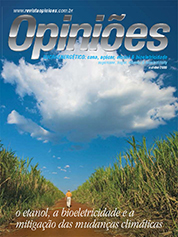Tadeu Luiz Colucci de Andrade
Research and Development Director of CTC
Op-AA-22
Research in the sustainability of the sugar-based energy sector
Serious reflection on the imposed changes of the last 30 years, such as climate change, alternative fuels, and new sources of electricity (and, more recently, bioelectricity) – and on how they affect the sugar and alcohol sector – is required. At the end of the 70’s, the world was shaken by an extremely high increase of the price of oil, which, until then, constituted the energy matrix.
Looking for alternatives became a priority, while questioning the forms and the consequences of these alternatives was done very little or not at all. Thus, at the time, in Brazil, alcohol fuel prevailed, and brought about a technological revolution in the sugarcane industry. Until then, cane was essentially used to make sugar. In a few exceptional cases, other varieties developed in other countries were grown. They were ill-suited for our production environment, but, in certain ways, met the demand.
When alcohol became an alternative to oil, production at the time showed a need for more productive varieties that could meet not only the demand for sugar, but also the needs of the new alcohol fuel market, while being cultivated in areas considered inappropriate for planting cane. At that time, genetic improvement programs of this crop gained momentum and changed the industry’s profile. Production per hectare increased constantly and Brazil consolidated its leading position in this crop.
However, even with the significance of this industry, prevailing agricultural practices were not questioned. The incineration of cane, the use of fertilizers, the way how soil was prepared and water consumed followed the customs of that time. However, a new fact did call attention: vinasse, a sub-product of alcohol production.
Following the negative impact that resulted from it being dumped into the environment, research showed that this sub-product is a high-value input for the very cultivation of sugarcane. Nowadays, environmental awareness is present in all human activities. Increasingly, one questions the impact caused on the environment, whether in production or consumption. With alcohol fuel (or ethanol) the same happens.
The old agro-industrial practices are no longer accepted. Nowadays, the industry is concerned with the expansion of the crop’s agricultural frontier, with the volume of fertilizers used, with labor issues, etc. Again, research plays a fundamental role: genetic improvement programs, new agricultural practices and cutting methods, loading and transporting, and even industrial processes.
If, in the past, Brazilian research generated the technology that supported the industry’s rowth, nowadays the generated technologies seek to solve the problems detected in agro-industry practice. In the current scenario, the CTC - Sugarcane Plantation Technology Center is fully equipped to meet the new demands. It diversified its genetic improvement program and it is present at all its associates, selecting high production varieties for all edaphoclimatic environments.
In the last five years, twenty high productivity varieties were made available to the associates. The CTC developed new agricultural practices, and currently the crop’s expansion occurs in a sustainable manner, with mechanized planting and harvesting using high-precision equipment for cutting cane and with minimal impact on the recovery of the stems. The option for the biological control of plagues results in that the sugarcane crop is among those that minimally use agrochemicals.
The CTC – Sugarcane Plantation Technology Center developed a technology that takes into consideration the soil/climate of each region, so that agricultural practices can be adopted in more rational ways, from selecting the plant variety, to an area’s cultivation system. In the industrial area, new ethanol production processes that will revolutionize the current fermentation process (with a significant reduction in the generation of sub-products) are being developed.
The use of biomass, until then a raw material in the generation of energy for the industrial process itself, will constitute a new product platform. Cellulosic ethanol will be the first biomass product, which already exists in CTC’s labs. The next step will be the commercial use of the technology. With the introduction of gasification using biomass it will be possible to obtain fertilizers, biofuel, biopolymers and high-production bioelectricity processes.
In the field of molecular biology, studies made by CTC will result in higher productivity, by introducing characteristics not achievable through conventional genetic improvement. Thus, new varieties will tolerate hydric stress and be resistant to plagues and diseases and they will be highly efficient for the use of fertilizers, warranting agricultural efficiency at levels never before achieved. Like in the past, the selection of ethanol as an alternative to oil was supported and justified by scientific research; nowadays, to the extent it will depend on research conducted at CTC, ethanol and all other products generated from sugarcane will be long-lived, consolidating the country’s agricultural force.




